接上篇:Vue2剥丝抽茧-响应式系统 (opens new window) ,没看的同学需要先看一下。
# 场景
我们考虑一下下边的代码会输出什么。
import { observe } from "./reactive";
import Watcher from "./watcher";
const data = {
text: "hello, world",
ok: true,
};
observe(data);
const updateComponent = () => {
console.log("收到", data.ok ? data.text : "not");
};
new Watcher(updateComponent); // updateComponent 执行一次函数,输出 hello, world
data.ok = false; // updateComponent 执行一次函数,输出 not
data.text = "hello, liang"; // updateComponent 会执行吗?
我们来一步一步理清:
# observer(data)
拦截了 data 中 text 和 ok 的 get、set,并且各自初始化了一个 Dep 实例,用来保存依赖它们的 Watcher 对象。
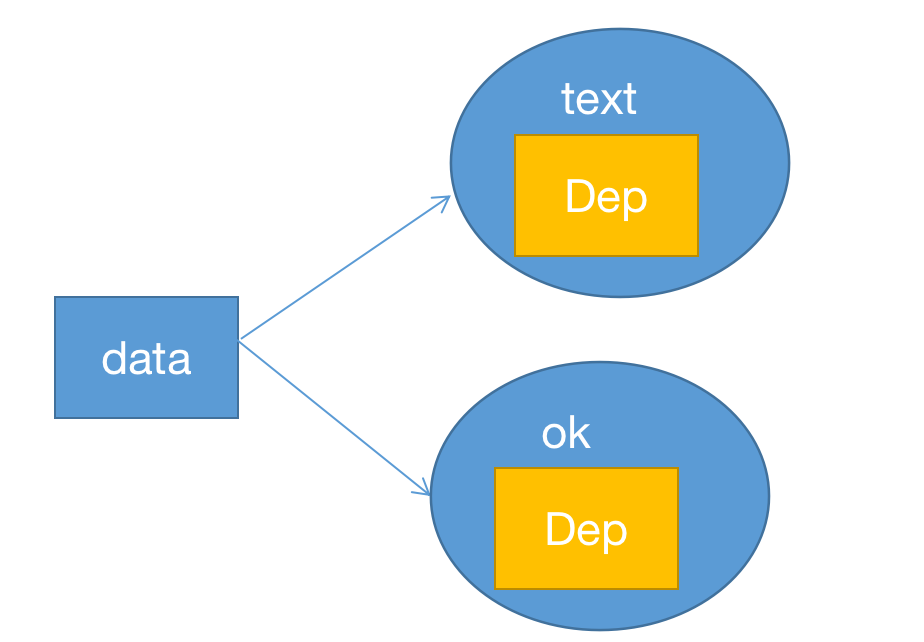
# new Watcher(updateComponent);
这一步会执行 updateComponent 函数,执行过程中用到的所有对象属性,会将 Watcher 收集到相应对象属性中的Dep 中。
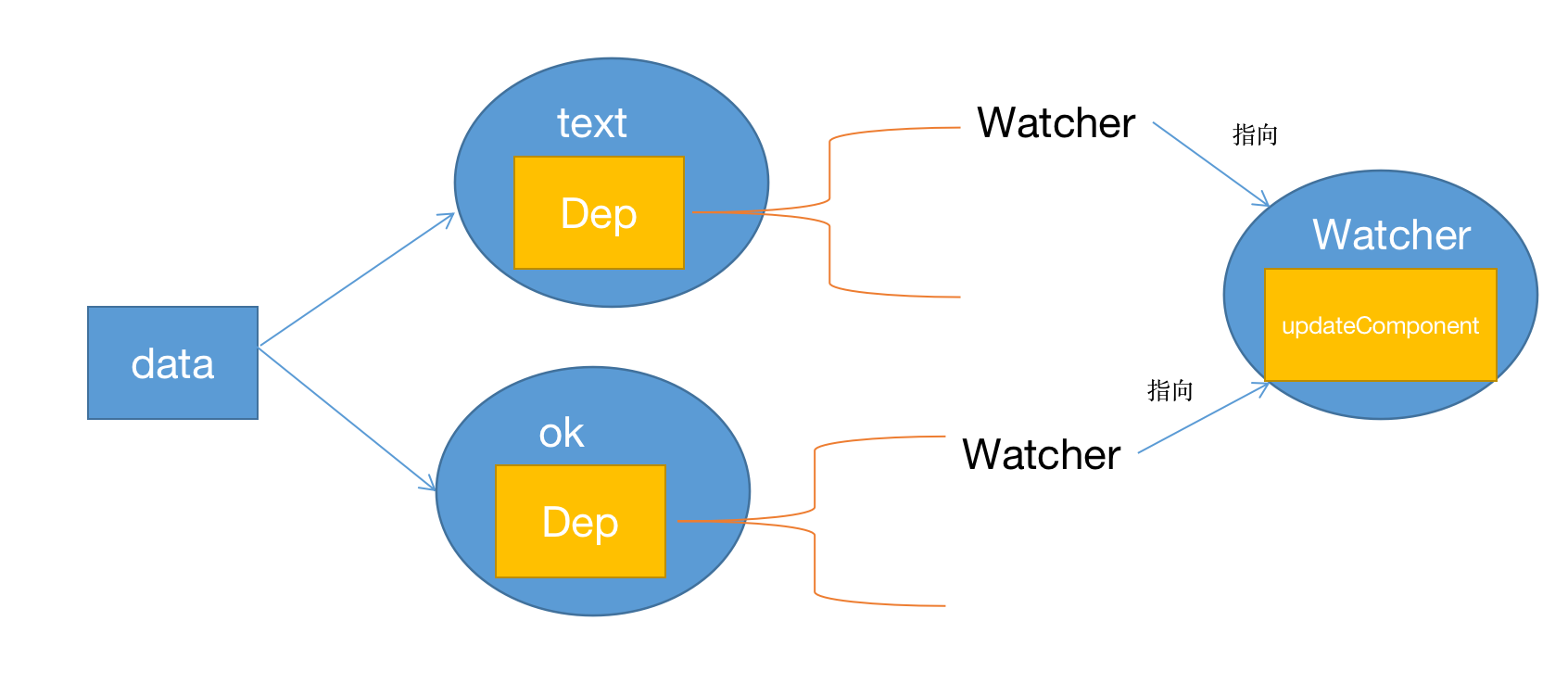
当然这里的 Watcher 其实是同一个,所以用了指向的箭头。
# data.ok = false;
这一步会触发 set ,从而执行 Dep 中所有的 Watcher ,此时就会执行一次 updateComponent 。
执行 updateComponent 就会重新读取 data 中的属性,触发 get,然后继续收集 Watcher 。
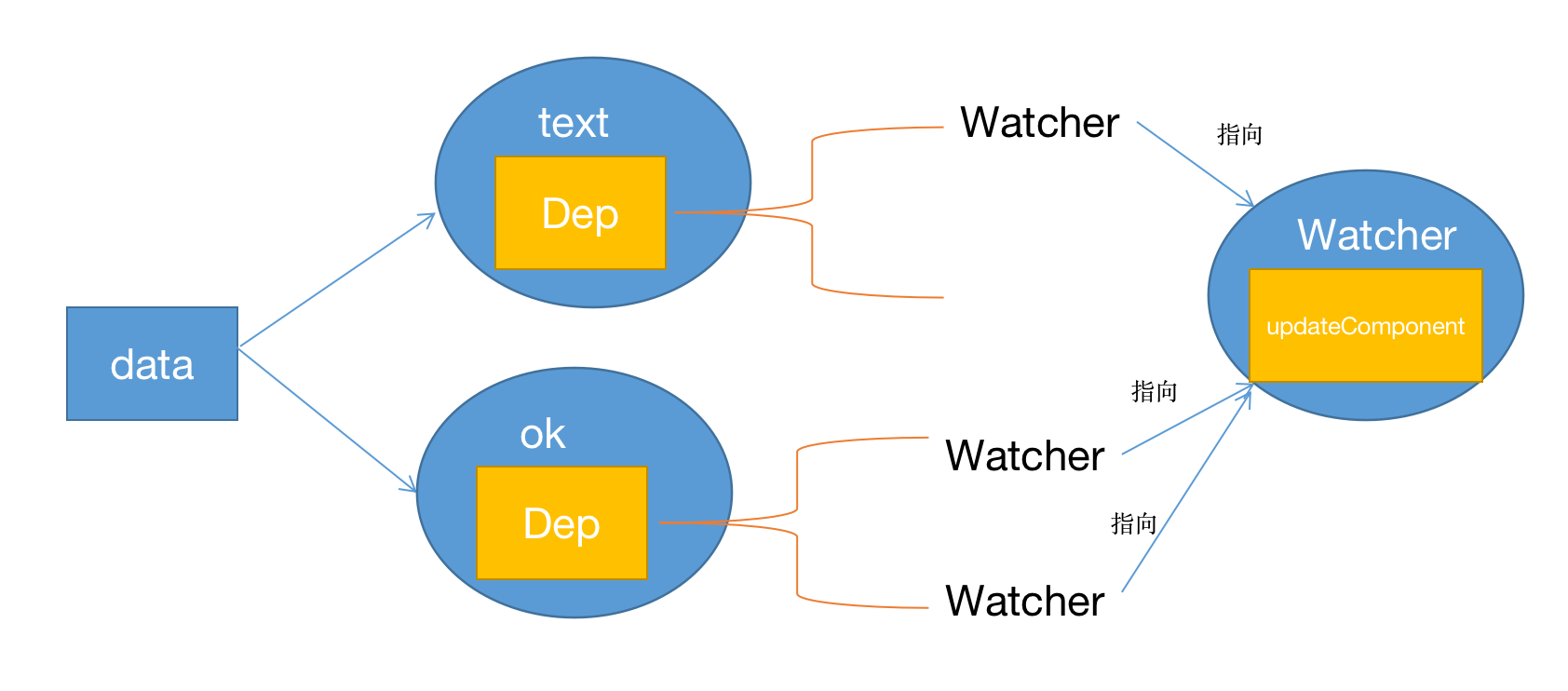
重新执行 updateComponent 函数 的时候:
const updateComponent = () => {
console.log("收到", data.ok ? data.text : "not");
};
因为 data.ok 的值变为 false ,所以就不会触发 data.text 的 get ,text 的 Dep 就不会变化了。
而 data.ok 会继续执行,触发 get 收集 Watcher ,但由于我们 Dep 中使用的是数组,此时收集到的两个 Wacher 其实是同一个,这里是有问题,会导致 updateComponent 重复执行,一会儿我们来解决下。
# data.text = "hello, liang";
执行这句的时候,会触发 text 的 set,所以会执行一次 updateComponent 。但从代码来看 updateComponent 函数中由于 data.ok 为 false,data.text 对输出没有任何影响,这次执行其实是没有必要的。
之所以执行了,是因为第一次执行 updateComponent 读取了 data.text 从而收集了 Watcher ,第二次执行 updateComponent 的时候,data.text 虽然没有读到,但之前的 Watcher 也没有清除掉,所以这一次改变 data.text 的时候 updateComponent 依旧会执行。
所以我们需要的就是当重新执行 updateComponent 的时候,如果 Watcher 已经不依赖于某个 Dep 了,我们需要将当前 Watcher 从该 Dep 中移除掉。
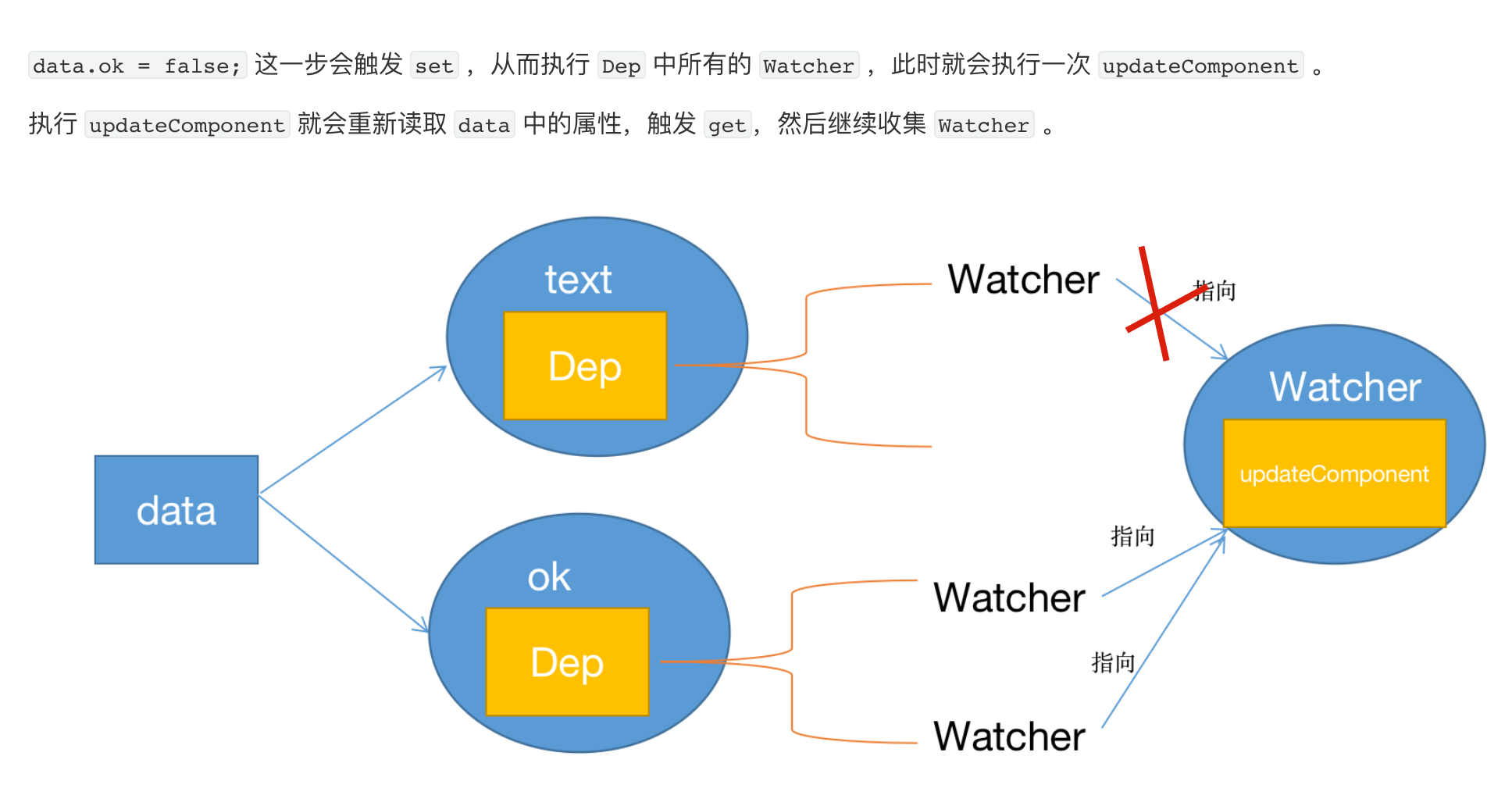
# 问题
总结下来我们需要做两件事情。
- 去重,
Dep中不要重复收集Watcher。 - 重置,如果该属性对
Dep中的Wacher已经没有影响了(换句话就是,Watcher中的updateComponent已经不会读取到该属性了 ),就将该Watcher从该属性的Dep中删除。
# 去重
去重的话有两种方案:
Dep中的subs数组换为Set。- 每个
Dep对象引入id,Watcher对象中记录所有的Dep的id,下次重新收集依赖的时候,如果Dep的id已经存在,就不再收集该Watcher了。
Vue2 源码中采用的是方案 2 这里我们实现下:
Dep 类的话只需要引入 id 即可。
/*************改动***************************/
let uid = 0;
/****************************************/
export default class Dep {
static target; //当前在执行的函数
subs; // 依赖的函数
id; // Dep 对象标识
constructor() {
/**************改动**************************/
this.id = uid++;
/****************************************/
this.subs = []; // 保存所有需要执行的函数
}
addSub(sub) {
this.subs.push(sub);
}
depend() {
if (Dep.target) {
// 委托给 Dep.target 去调用 addSub
Dep.target.addDep(this);
}
}
notify() {
for (let i = 0, l = this.subs.length; i < l; i++) {
this.subs[i].update();
}
}
}
Dep.target = null; // 静态变量,全局唯一
在 Watcher 中,我们引入 this.depIds 来记录所有的 id 。
import Dep from "./dep";
export default class Watcher {
constructor(Fn) {
this.getter = Fn;
/*************改动***************************/
this.depIds = new Set(); // 拥有 has 函数可以判断是否存在某个 id
/****************************************/
this.get();
}
/**
* Evaluate the getter, and re-collect dependencies.
*/
get() {
Dep.target = this; // 保存包装了当前正在执行的函数的 Watcher
let value;
try {
value = this.getter.call();
} catch (e) {
throw e;
} finally {
this.cleanupDeps();
}
return value;
}
/**
* Add a dependency to this directive.
*/
addDep(dep) {
/*************改动***************************/
const id = dep.id;
if (!this.depIds.has(id)) {
dep.addSub(this);
}
/****************************************/
}
/**
* Subscriber interface.
* Will be called when a dependency changes.
*/
update() {
this.run();
}
/**
* Scheduler job interface.
* Will be called by the scheduler.
*/
run() {
this.get();
}
}
# 重置
同样是两个方案:
- 全量式移除,保存
Watcher所影响的所有Dep对象,当重新收集Watcher的前,把当前Watcher从记录中的所有Dep对象中移除。 - 增量式移除,重新收集依赖时,用一个新的变量记录所有的
Dep对象,之后再和旧的Dep对象列表比对,如果新的中没有,旧的中有,就将当前Watcher从该Dep对象中移除。
Vue2 中采用的是方案 2,这里也实现下。
首先是 Dep 类,我们需要提供一个 removeSub 方法。
import { remove } from "./util";
/*
export function remove(arr, item) {
if (arr.length) {
const index = arr.indexOf(item);
if (index > -1) {
return arr.splice(index, 1);
}
}
}
*/
let uid = 0;
export default class Dep {
static target; //当前在执行的函数
subs; // 依赖的函数
id; // Dep 对象标识
constructor() {
this.id = uid++;
this.subs = []; // 保存所有需要执行的函数
}
addSub(sub) {
this.subs.push(sub);
}
/*************新增************************/
removeSub(sub) {
remove(this.subs, sub);
}
/****************************************/
depend() {
if (Dep.target) {
// 委托给 Dep.target 去调用 addSub
Dep.target.addDep(this);
}
}
notify() {
for (let i = 0, l = this.subs.length; i < l; i++) {
this.subs[i].update();
}
}
}
Dep.target = null; // 静态变量,全局唯一
然后是 Watcher 类,我们引入 this.deps 来保存所有的旧 Dep 对象,引入 this.newDeps 来保存所有的新 Dep 对象。
import Dep from "./dep";
export default class Watcher {
constructor(Fn) {
this.getter = Fn;
this.depIds = new Set(); // 拥有 has 函数可以判断是否存在某个 id
/*************新增************************/
this.deps = [];
this.newDeps = []; // 记录新一次的依赖
this.newDepIds = new Set();
/****************************************/
this.get();
}
/**
* Evaluate the getter, and re-collect dependencies.
*/
get() {
Dep.target = this; // 保存包装了当前正在执行的函数的 Watcher
let value;
try {
value = this.getter.call();
} catch (e) {
throw e;
} finally {
/*************新增************************/
this.cleanupDeps();
/****************************************/
}
return value;
}
/**
* Add a dependency to this directive.
*/
addDep(dep) {
const id = dep.id;
/*************新增************************/
// 新的依赖已经存在的话,同样不需要继续保存
if (!this.newDepIds.has(id)) {
this.newDepIds.add(id);
this.newDeps.push(dep);
if (!this.depIds.has(id)) {
dep.addSub(this);
}
}
/****************************************/
}
/**
* Clean up for dependency collection.
*/
/*************新增************************/
cleanupDeps() {
let i = this.deps.length;
// 比对新旧列表,找到旧列表里有,但新列表里没有,来移除相应 Watcher
while (i--) {
const dep = this.deps[i];
if (!this.newDepIds.has(dep.id)) {
dep.removeSub(this);
}
}
// 新的列表赋值给旧的,新的列表清空
let tmp = this.depIds;
this.depIds = this.newDepIds;
this.newDepIds = tmp;
this.newDepIds.clear();
tmp = this.deps;
this.deps = this.newDeps;
this.newDeps = tmp;
this.newDeps.length = 0;
}
/****************************************/
/**
* Subscriber interface.
* Will be called when a dependency changes.
*/
update() {
this.run();
}
/**
* Scheduler job interface.
* Will be called by the scheduler.
*/
run() {
this.get();
}
}
# 测试
回到开头的代码
import { observe } from "./reactive";
import Watcher from "./watcher";
const data = {
text: "hello, world",
ok: true,
};
observe(data);
const updateComponent = () => {
console.log("收到", data.ok ? data.text : "not");
};
new Watcher(updateComponent); // updateComponent 执行一次函数,输出 hello, world
data.ok = false; // updateComponent 执行一次函数,输出 not
data.text = "hello, liang"; // updateComponent 会执行吗?
此时 data.text 修改的话就不会再执行 updateComponent 了,因为第二次执行的时候,我们把 data.text 中 Dep 里的 Watcher 清除了。
# 总
今天这个主要就是对响应式系统的一点优化,避免不必要的重新执行。所做的事情就是重新调用函数的时候,把已经没有关联的 Watcher 去除。
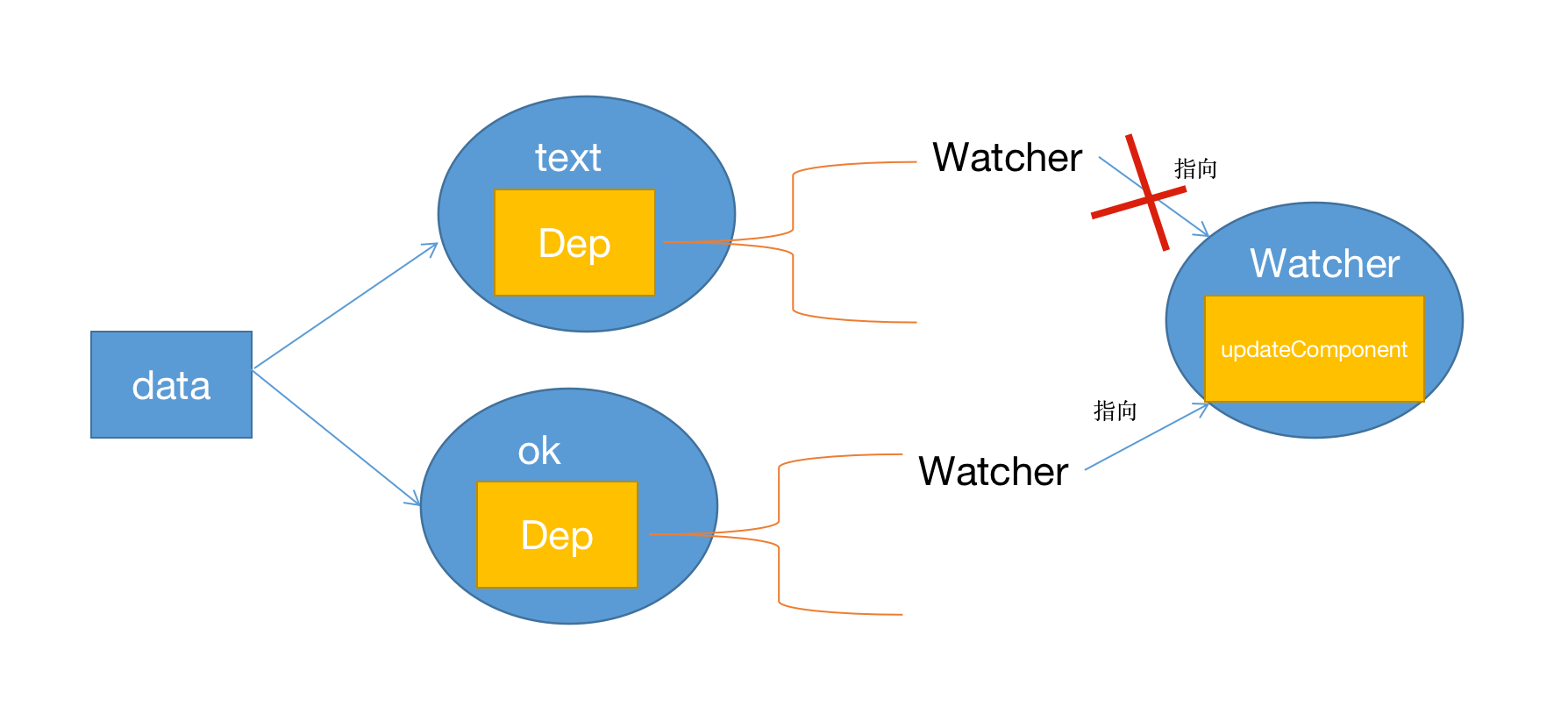
不知道看到这里大家有没有一个疑问,我是一直没想到说服我的点,欢迎一起交流:
在解决去重问题上,我们是引入了 id ,但如果直接用 set 其实就可以。在 Watcher 类中是用 Set 来存 id ,用数组来存 Dep 对象,为什么不直接用 Set 来存 Dep 对象呢?
2022.4.17 更新,之前漏看了 Set 的导入,之所以用数组其实是为了兼容性,Set 实现了简易版的 polyfill,降级后的 Set 仅支持存数字和字符串等原始值,也就是对象 key 支持的类型。
看下边的代码应该就理解了。
// src/core/util/env.js
let _Set
/* istanbul ignore if */ // $flow-disable-line
if (typeof Set !== 'undefined' && isNative(Set)) {
// use native Set when available.
_Set = Set
} else {
// a non-standard Set polyfill that only works with primitive keys.
_Set = class Set implements SimpleSet {
set: Object;
constructor () {
this.set = Object.create(null)
}
has (key: string | number) {
return this.set[key] === true
}
add (key: string | number) {
this.set[key] = true
}
clear () {
this.set = Object.create(null)
}
}
}
export { _Set }
← 1.响应式系统 3.响应式系统之嵌套 →